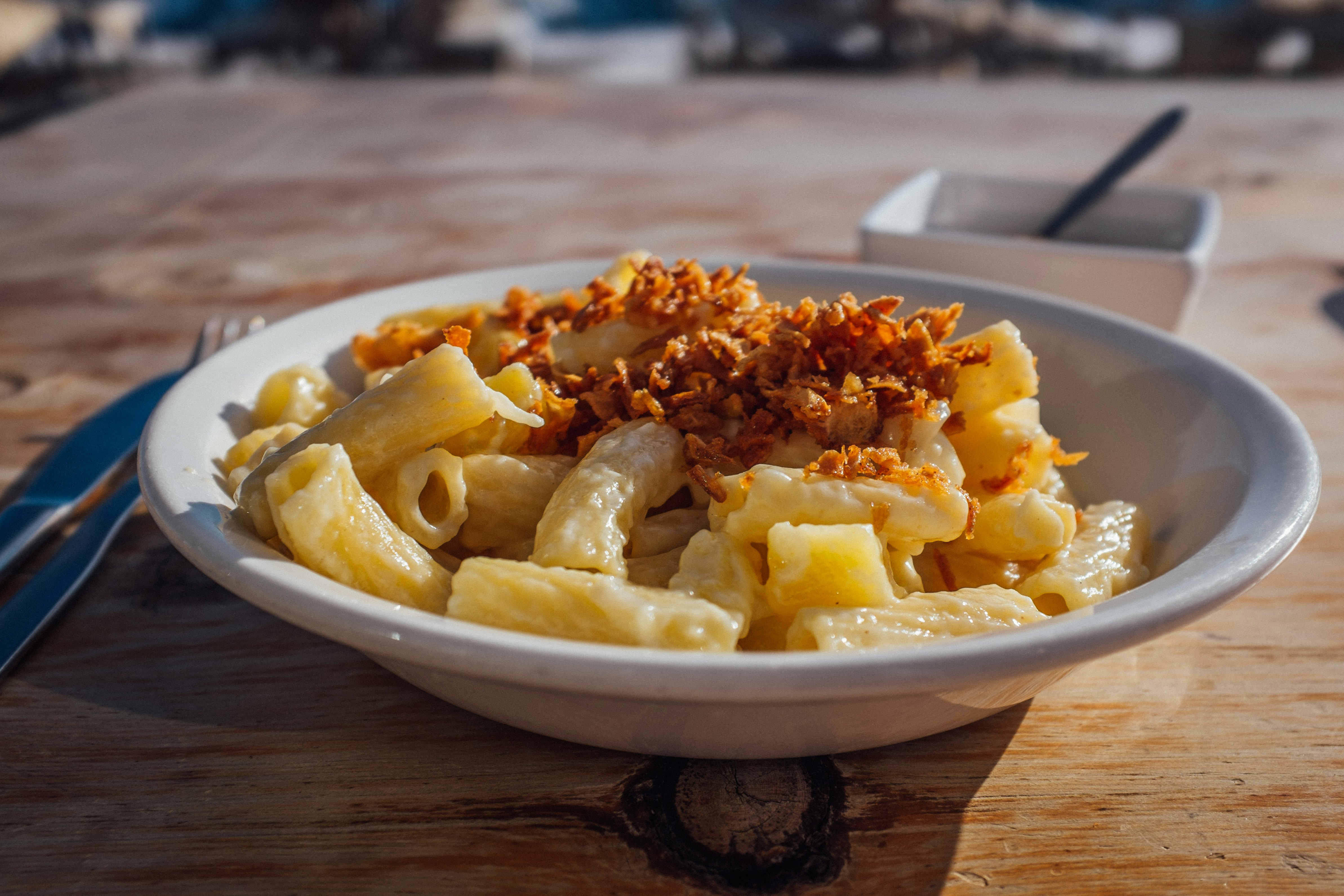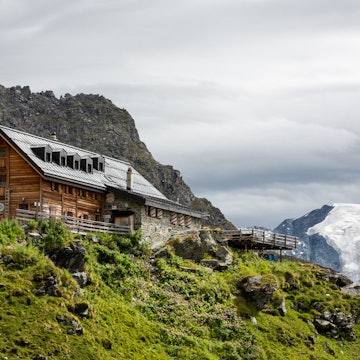

Cervelat is a small sausage traditionally eaten round the campfire in Switzerland. Michaela Leona/Shutterstock
With four official languages yet a distinct sense of national identity, Switzerland is a mix of cultures and at the same time innately Swiss – and that goes for its cuisine, too.
Different regions draw on culinary influences from the neighboring countries of Italy, Germany, France and Austria, while sharing a love of homegrown products born of the country’s beautiful landscape. There's beef and dairy from the alpine pastures, fish from Lake Geneva, wheat from the country’s "breadbasket" region north of Lausanne, and fruit from its sunny plains. Switzerland also has many vineyards, which create an important wine-growing – and drinking – culture that the Swiss are happy to keep mainly to themselves.
Plan your menu hit list with this guide to the best food and drink to try in Switzerland.

Dip into fondue, the classic Swiss hot cheese dish
The dish most associated with Switzerland, fondue – from the French verb fondre, meaning to melt – is available in restaurants all over the country, while some mountain villages even have vending machines selling packets of fondue mix to prepare at home.
A classic Swiss fondue is moitié-moitié, meaning half Gruyère cheese and half Vacherin Fribourgeois, melted in a caquelon (fondue pot) with white wine, garlic and kirsch (brandy), and served with cubes of bread to dunk into the gooey goodness using a long fork. There are also versions with tomatoes or bolet mushrooms, served with boiled potatoes. Whichever you go for, it’s not finished until you’ve fought over the religieuse – the crusty bit at the bottom.
While fondue is usually – but not only – eaten in winter, raclette is a hot cheese dish suitable for any time, whether in a restaurant, at home with friends or at a tiny summer festival in the middle of nowhere. A half round of Raclette du Valais cheese is placed on a special machine that melts the top layer; this is then scraped onto a plate and served with a couple of boiled potatoes, gherkins and pickled onions. The idea is you keep going back for more until the wheel is finished or your stomach is fit to burst, whatever comes first.
Where to try it: Restaurant Les Armures in Geneva’s Old Town is well known for its fondue and raclette.

Try rösti, the nation’s favorite potato dish
Most associated with the Swiss German region, rösti is so much a part of Switzerland that it’s even lent its name to the invisible language border between the French and German-speaking parts, colloquially known as the Röstigraben (literally, the Rösti rift). In fact, there’s little regional division when it comes to enjoying this crispy, fried, grated potato cake – it’s eaten all over the country, in both cities and mountain restaurants. Popular toppings include lardons, mushrooms, a fried egg and – of course – cheese, or have it as a side dish with bratwurst sausage or Kalbsgeschnetzeltes, a Zürich specialty of veal in a cream and white wine sauce.
Where to try it: Head to Zürich’s Zeughauskeller, a traditional tavern that serves rösti with everything, or buy a packet of rösti in any supermarket and cook it yourself (never quite as good but still very tasty).
Enjoy fish from Lac Léman
The vast expanse of Switzerland’s largest lake, Lac Léman (Lake Geneva) is home to fish including trout, perch and fera, so their appearance on menus around the lake is ubiquitous. Order a classic filets de perche meunière and you’ll get around ten filets of the small fish, served in a lemon and butter sauce with fries on the side. Be aware, however – so popular is the dish these days that demand outstrips supply and much of the fish is imported from elsewhere.
Where to try it: Café de la Poste in the lakeside village of Lutry does a delicious filets de perche menuière along with other fish and seafood dishes. Book ahead for a spot on the terrace.

Fill up on alpine macaroni
Carb-loaders, rejoice! Älplermagronen is a filling dish created to give local farmers plenty of energy to work the rugged alpine terrain. But you don't need a day of hard labor ahead to chow down on a steaming bowl of this so-called alpine macaroni.
Essentially a Swiss version of macaroni cheese, it’s a combination of pasta and cubes of potato in a rich cheese and cream sauce, served with crispy fried onions and apple sauce. The latter may seem an odd addition but the sweet acidity of the apples cuts through the rich sauce, making it all the easier to shovel in another delicious mouthful.
Where to try it: You’ll find a version of this in many mountain restaurants, including at the Engstligenalp near Adelboden. Be warned – it’s a huge portion.
Sample Switzerland’s sausages
You won’t be in Switzerland long before encountering a sausage or two. The St Galler Bratwurst, a pork and veal sausage with a pale color, is a standard Swiss snack at any festival, grilled and served with mustard and a hunk of bread, while the Schüblig, a smoked pork or beef sausage, often sits alongside it on the grill. A traditional dish in French-speaking parts is papet vaudois, a pork and cabbage sausage cooked with leeks and potatoes. And don’t miss Switzerland’s national sausage, the humble cervelat, a small, smoked sausage traditionally eaten around the campfire; slash each end with a cross, put it on a stick and watch as it curls up over the flames.
Where to try it: Le Vaudois in Lausanne is a good place to tuck into a classic papet vaudois.

Try risotto or polenta in a Ticinese grotto
Firmly influenced by its Italian neighbor, the southern Swiss canton of Ticino feels different from the rest of the country. Its many grotti – simple restaurants usually with a shaded garden – serve typical dishes including polenta and risotto; the rice is even grown here, in the Vallemaggia. Chestnuts are another locally grown product, used to make cake, honey, jam and vermicelles, a chestnut puree dessert that’s popular all over Switzerland.
Where to try it: Tuck into traditional Ticinese dishes at the popular Grotto Morchino outside Lugano.
Treat yourself to meringues and cream in Gruyères
The village of Gruyères may be world-famous for its cheese, but in Switzerland it’s nearly as well-known for its double cream, made from the fat skimmed off the milk used for producing the cheese. And this isn’t any old double cream, but a particularly thick, unctuous version (not quite as thick as clotted, but almost) that goes perfectly with light-as-air meringues, another speciality of the village. So beloved is this classic Swiss dessert that there’s even a double cream festival in Gruyères each year.
Where to try it: Find la crème double de la Gruyère and its accompanying meringues in any supermarket in Switzerland, or book a table at Le Chalet de Gruyères to sample the village’s specialities on site.

Sip local wine
Switzerland isn’t known internationally as a wine-producing country, so visitors are often surprised to see vineyards carpeting the slopes of Lake Geneva and down the Rhône valley. The country has around 1500 producers across six wine regions, but it hardly exports any of its wine, leaving the Swiss to – very enthusiastically – drink it themselves.
Chasselas, or Fendant as it's known in the Valais, is the most widespread white wine, while Pinot Noir and Merlot are common reds, the latter in Ticino particularly. In addition to wine, the fruit orchards of the Valais give us schnapps; Williamine, made from Williams pears, and Abricotine, from apricots, are the two best known. Non-drinkers, meanwhile, should try the popular Swiss soft drink Rivella, made from milk whey, or herbal teas made from alpine flowers and herbs, available in most restaurants and supermarkets.
Where to try it: Taste wines from the Lavaux region at the restaurant Tout Un Monde in Grandvaux, whose beautiful terrace overlooks the centuries-old vineyards where the wine originates.

Leave room for Swiss chocolate
Switzerland was a pioneer in the development of milk chocolate and solid chocolate bars, and its reputation for the sweet stuff has endured thanks to big names including Nestlé, Lindt and Cailler, all of which are still headquartered here more than 150 years after their initial foray into chocolate production. These days, varieties are myriad – for something a little different, try Villars’s blond blend, or Callebaut’s ruby chocolate, the most recent choc on the block.
Where to try it: There are chocolate shops in every Swiss town. Look out for the chain Läderach, which has a wide range of products, or step into an independent chocolatier such as Auer in Geneva or Schiesser in Basel.
There are good plant-based options for vegetarians
Switzerland is quite an easy country for vegetarians, with many of its classic cheese dishes either naturally meat-free or optionally so. Vegans, however, might find life more difficult thanks to the country’s love of dairy. Nevertheless, the trend for plant-based food has really taken off in Switzerland of late. Hiltl, a longstanding vegetarian restaurant in Zürich, is now joined by Tibits, a popular meat-free buffet restaurant with branches across the country, along with independent places serving wholly or partly plant-based menus, like the upmarket KLE in Zürich. Supermarkets also increasingly stock plant-based meat substitutes.
















